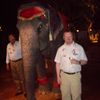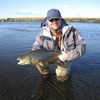Laki or Lakagígar (Craters of Laki) is a volcanic fissure situated in the south of Iceland, not far from the canyon of Eldgjá and the small village Kirkjubćjarklaustur, in South-East Iceland. Lakagígar is the correct name as the Laki mountain itself did not erupt, but fissures opened up on each side of it. Lakagígar is part of a volcanic system, centering on the Grímsvötn volcano and including the Thórdarhyrna volcano.[1][2][3] It lies between the glaciers of Mýrdalsjökull and Vatnajökull, in an area of fissures which run in a south-west to north-east direction.
The system erupted over an 8 month period during 1783-1784 from the Laki fissure and the adjoining Grímsvötn volcano, pouring out an estimated 14 km3 (3.4 cu mi) of basalt lava and clouds of poisonous hydrofluoric acid/sulfur-dioxide compounds that killed over 50% of Iceland's livestock population, leading to famine which killed approximately 25% of the population[4].
The Laki eruption has been estimated to have killed over two million people[5] globally, making it the deadliest volcanic eruption in historical times. The drop in temperatures, due to the sulfuric dioxide gases spewed into the northern hemisphere, caused crop failures in Europe, droughts in India, and Japan's worst famine.
Contents[hide] |
[edit] 1783 eruption
On 8 June 1783, a fissure with 130 craters opened with phreatomagmatic explosions because of the groundwater interacting with the rising basalt magma. Over a few days the eruptions became less explosive, Strombolian, and later Hawaiian in character, with high rates of lava effusion. This event is rated as VEI 6 on the Volcanic Explosivity Index, but the eight month emission of sulfuric aerosols resulted in one of the most important climatic and socially repercussive events of the last millennium.[6]
The eruption, also known as the Skaftáreldar ("Skaftá fires") or Síđueldur, produced an estimated 14 km3 (3.4 cu mi) of basalt lava, and the total volume of tephra emitted was 0.91 km3 (0.2 cu mi).[1] Lava fountains were estimated to have reached heights of 800-1400 m (~2,600-4,600 ft). In Great Britain, the summer of 1783 was known as the "sand-summer" due to ash fallout.[7] The gases were carried by the convective eruption column to altitudes of about 15 kilometres (10 mi). .
The eruption continued until 7 February 1784, but most of the lava was erupted in the first five months. Grímsvötn volcano, from which the Laki fissure extends, was also erupting at the time from 1783 until 1785. The outpouring of gases, including an estimated 8 million tons of hydrogen fluoride and estimated 120 million tons of sulfur dioxide, gave rise to what has since become known as the "Laki haze" across Europe.
[edit] Consequences in Iceland
The consequences for Iceland—known as the Mist Hardships—were catastrophic.[8] An estimated 20-25% of the population died in the famine and fluorine poisoning after the fissure eruptions ceased. Around 80% of sheep, 50% of cattle and 50% of horses died because of dental and skeletal fluorosis from the 8 million tons of hydrogen fluoride that were released.[7][9]
The parish priest Jón Steingrímsson grew famous because of his eldmessa ("fire sermon"). The people of the small settlement of Kirkjubćjarklaustur were worshipping while the village was endangered by a lava stream, which ceased to flow not far from town, with the townsfolk still in church.
- "This past week, and the two prior to it, more poison fell from the sky than words can describe: ash, volcanic hairs, rain full of sulfur and saltpeter, all of it mixed with sand. The snouts, nostrils, and feet of livestock grazing or walking on the grass turned bright yellow and raw. All water went tepid and light blue in color and gravel slides turned gray. All the earth's plants burned, withered and turned gray, one after another, as the fire increased and neared the settlements."[10]
[edit] Consequences in Europe
An estimated 120 million tons of sulfur dioxide were emitted, about three times the total annual European industrial output in 2006, and equivalent to a 1991 Mount Pinatubo eruption every three days.[7] This outpouring of sulfur dioxide during unusual weather conditions caused a thick haze to spread across western Europe, resulting in many thousands of deaths throughout 1783 and the winter of 1784.
The summer of 1783 was the hottest on record and a rare high pressure zone over Iceland caused the winds to blow to the south-east.[7] The poisonous cloud drifted to Bergen in Norway, then spread to Prague in the Kingdom of Bohemia (now in the Czech Republic) by 17 June, Berlin by 18 June, Paris by 20 June, Le Havre by 22 June, and to Great Britain by 23 June. The fog was so thick that boats stayed in port, unable to navigate, and the sun was described as "blood coloured".[7]
Inhaling sulfur dioxide gas causes victims to choke as their internal soft tissue swells. The local death rate in Chartres was up by 5% during August and September, with over 40 dead. In Great Britain, the records show that the additional deaths were outdoor workers; the death rate in Bedfordshire, Lincolnshire and the east coast was perhaps two or three times the normal rate . It has been estimated that 23,000 British people died from the poisoning.[11]
The weather became very hot, causing severe thunderstorms with large hailstones that were reported to have killed cattle,[12] until the haze dissipated in the autumn. The winter of 1784 was most severe;[13] Gilbert White at Selborne in Hampshire reported 28 days of continuous frost. The extreme winter is estimated to have caused 8,000 additional deaths in the UK. In the spring thaw, Germany and Central Europe reported severe flood damage.[7]
The meteorological impact of Laki continued, contributing significantly to several years of extreme weather in Europe. In France a sequence of extremes included a surplus harvest in 1785 that caused poverty for rural workers, accompanied by droughts and bad winters and summers, including a violent hailstorm in 1788 that destroyed crops. These events contributed significantly to a build-up of poverty and famine that may have contributed to the French Revolution in 1789[citation needed]. Laki was only one factor in a decade of climatic disruption, as Grímsvötn was erupting from 1783 to 1785, and a 1998 study of El Nińo patterns suggests an unusually strong El Nińo effect from 1789 to 1793.[14]
[edit] Consequences in North America
In North America, the winter of 1784 was the longest and one of the coldest on record. It was the longest period of below-zero temperatures in New England, the largest accumulation of snow in New Jersey, and the longest freezing over of the Chesapeake Bay. There was ice skating in Charleston Harbor, a huge snowstorm hit the south, the Mississippi River froze at New Orleans, and there was ice in the Gulf of Mexico.[15][16]
[edit] Consequences elsewhere
There is evidence that the Laki eruption had other effects beyond Europe, with weakened African and Indian monsoon circulations, leading to between 1 and 3 millimetres (0.04 and 0.12 in) less daily precipitation than normal over the Sahel of Africa, resulting in, among other effects, low flow in the River Nile.[17]
The famine that afflicted Egypt in 1784 cost it roughly one-sixth of its population.[18]
The eruption may also have exacerbated the Tenmei famine in Japan.
[edit] Contemporary reports
Gilbert White recorded his perceptions of the event at Selborne, Hampshire, England:
- The summer of the year 1783 was an amazing and portentous one, and full of horrible phaenomena; for besides the alarming meteors and tremendous thunder-storms that affrighted and distressed the different counties of this kingdom, the peculiar haze, or smokey fog, that prevailed for many weeks in this island, and in every part of Europe, and even beyond its limits, was a most extraordinary appearance, unlike anything known within the memory of man. By my journal I find that I had noticed this strange occurrence from June 23 to July 20 inclusive, during which period the wind varied to every quarter without making any alteration in the air. The sun, at noon, looked as blank as a clouded moon, and shed a rust- coloured ferruginous light on the ground, and floors of rooms; but was particularly lurid and blood-coloured at rising and setting. All the time the heat was so intense that butchers' meat could hardly be eaten on the day after it was killed; and the flies swarmed so in the lanes and hedges that they rendered the horses half frantic, and riding irksome. The country people began to look, with a superstitious awe, at the red, louring aspect of the sun; [...][19]
Benjamin Franklin recorded his observations in a 1784 lecture:
- During several of the summer months of the year 1783, when the effect of the sun's rays to heat the earth in these northern regions should have been greater, there existed a constant fog over all Europe, and a great part of North America. This fog was of a permanent nature; it was dry, and the rays of the sun seemed to have little effect towards dissipating it, as they easily do a moist fog, arising from water. They were indeed rendered so faint in passing through it, that when collected in the focus of a burning glass they would scarce kindle brown paper. Of course, their summer effect in heating the Earth was exceedingly diminished. Hence the surface was early frozen. Hence the first snows remained on it unmelted, and received continual additions. Hence the air was more chilled, and the winds more severely cold. Hence perhaps the winter of 1783-4 was more severe than any that had happened for many years.
- The cause of this universal fog is not yet ascertained [...] or whether it was the vast quantity of smoke, long continuing, to issue during the summer from Hekla in Iceland, and that other volcano which arose out of the sea near that island, which smoke might be spread by various winds, over the northern part of the world, is yet uncertain.[20] (According to contemporary records, Hekla did not erupt in 1783; its previous eruption was in 1766. The Laki fissure eruption was 45 miles (72 km)[21] to the east and the Grímsvötn volcano was erupting circa 75 miles (121 km)[22] north east. Additionally Katla, only 31 miles (50 km)[23] south east, was still renowned after its spectacular eruption 28 years earlier in 1755.)
The Reverend Sir John Cullum of Bury St Edmunds, Suffolk, Great Britain recorded on the 23rd June 1783, the same date that Gilbert White noted the beginning of the unusual atmospheric phenomena, in a letter to Sir Joseph Banks, then President of The Royal Society
- ...‘about six o’clock, that morning, I observed the air very much condensed in my chamber-window; and, upon getting up, was informed by a tenant that finding himself cold in bed, about three o’clock in the morning, he looked out at his window, and to his great surprise saw the ground covered with a white frost: and I was assured that two men at Barton, about three miles (5 km) off, saw in some shallow tubs, ice of the thickness of a crown-piece.’[24]
Sir John goes on to describe the effect of this ‘frost’ on trees and crops:
- ‘The aristae[25] of the barley, which was coming into ear, became brown and withered at their extremities, as did the leaves of the oats; the rye had the appearance of being mildewed; so that the farmers were alarmed for those crops…The larch, Weymouth pine, and hardy Scotch fir, had the tips of their leaves withered’.[24]
Sir John’s vegetable garden did not escape; he noted that the plants looked ‘exactly as if a fire had been lighted near them, that had shrivelled and discoloured their leaves’.
Fćrsluflokkar
Eldri fćrslur
- Júní 2023
- Júní 2020
- Mars 2018
- Desember 2012
- Desember 2011
- Október 2011
- Október 2010
- Júní 2010
- Apríl 2010
- Mars 2010
- Febrúar 2010
- Janúar 2010
- Desember 2009
- Nóvember 2009
- Október 2009
- September 2009
- Ágúst 2009
- Júlí 2009
- Júní 2009
- Maí 2009
- Apríl 2009
- Mars 2009
- Febrúar 2009
- Janúar 2009
- Desember 2008
- Nóvember 2008
- Október 2008
- September 2008
- Ágúst 2008
- Júlí 2008
- Maí 2008
- Apríl 2008
- Mars 2008
- Febrúar 2008
- Janúar 2008
- Desember 2007
- Nóvember 2007
- Október 2007
- September 2007
- Júlí 2007
- Júní 2007
- Maí 2007
- Apríl 2007
- Mars 2007
- Nóvember 2006
Bloggvinir
-
 godsamskipti
godsamskipti
-
 gummisteingrims
gummisteingrims
-
 andres
andres
-
 dofri
dofri
-
 sigmarg
sigmarg
-
 gattin
gattin
-
 agustolafur
agustolafur
-
 ellyarmanns
ellyarmanns
-
 emmgje
emmgje
-
 finnurtg
finnurtg
-
 tommi
tommi
-
 hipporace
hipporace
-
 arnheidurmagg
arnheidurmagg
-
 formula
formula
-
 baldvinj
baldvinj
-
 launafolk
launafolk
-
 dullur
dullur
-
 gisgis
gisgis
-
 eirikuro
eirikuro
-
 erla
erla
-
 folkerfifl
folkerfifl
-
 fridrikof
fridrikof
-
 ulfarsson
ulfarsson
-
 gerdurpalma112
gerdurpalma112
-
 gudni-is
gudni-is
-
 gullvagninn
gullvagninn
-
 jarnskvisan
jarnskvisan
-
 id
id
-
 fun
fun
-
 jamesblond
jamesblond
-
 jonthorolafsson
jonthorolafsson
-
 juliusvalsson
juliusvalsson
-
 ludvikludviksson
ludvikludviksson
-
 magnusmar
magnusmar
-
 marinogn
marinogn
-
 maggimur
maggimur
-
 hux
hux
-
 rrs
rrs
-
 sigurdurkari
sigurdurkari
-
 siggisig
siggisig
-
 sigurgeirorri
sigurgeirorri
-
 sigurjons
sigurjons
-
 snorrima
snorrima
-
 spurs
spurs
-
 vala
vala
-
 thordisb
thordisb
-
 tbs
tbs
-
 thrudur
thrudur
-
 vitinn
vitinn
Tenglar
Frábćr myndbönd
- Frábært gamalt myndband frá Jeremy Clarkson um Ísland Nokkuđ skemmtileg afţreying!
Hversu biluđ erum viđ?
http://www.psychiatry24x7.com/
Heimsóknir
Flettingar
- Í dag (18.9.): 0
- Sl. sólarhring:
- Sl. viku: 2
- Frá upphafi: 0
Annađ
- Innlit í dag: 0
- Innlit sl. viku: 2
- Gestir í dag: 0
- IP-tölur í dag: 0
Uppfćrt á 3 mín. fresti.
Skýringar






Athugasemdir
Sćll Haraldur, ţetta er nauđsynleg lesning í dag er ég hrćdd um og allir ćttu ađ lesa, hversu óţćgileg sem hún er. Sagan ţarna gćti kennt okkur mikiđ um hvađ ćtti ađ gera og hvernig er hćgt ađ bregđast viđ ef... Ég er einmitt búin ađ vera ađ lesa mér til um Lagagígagosiđ, og ţá ađdragandan á undan í skjálftum hér og ţar. Ţar sem ţađ er talađ um í dag ađ Eyjafjallajökull sé kveikjan og ég búinn ađ hafa ţađ á tilfinningunni í ein 3 til 4 ár ađ ţađ sé ţađ sem ađ viđ Íslendingar séum ađ fá yfir okkur annađ svona í líkingu viđ fyrra lakagígagos. En tilfinning ţarf ekki ađ gerast og vonandi ađ svo sé í ţessu tilfelli hjá mér.
Ingibjörg Guđrún Magnúsdóttir, 9.6.2010 kl. 20:46
Bćta viđ athugasemd [Innskráning]
Ekki er lengur hćgt ađ skrifa athugasemdir viđ fćrsluna, ţar sem tímamörk á athugasemdir eru liđin.